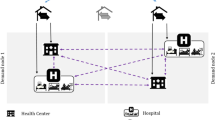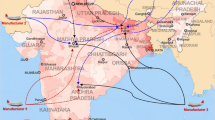Abstract
It is important to define optimal supply chain strategies that can respond to real vaccination needs in different disasters, especially in the event of a pandemic. The distribution of medicines and vaccines is more critical when they can decay and must arrive at their final destination as fast as possible. In this paper, to overcome these problems and respond to the pandemic of COVID-19 needs, we introduced a bi-objective model for the distribution of COVID-19 vaccines. The objectives are to minimize cost function and to minimize the maximum traveling time of the vaccines to treat targeted populations in different time phases. The bi-objective model is solved with the well-known multi-objective augmented epsilon-constraint method. Besides, we bring numerical results and the appliance of our proposed model. By solving the proposed model, we can find the optimal network of the vaccines and open needed facilities in several locations. Finally, we give the decision-maker several possible answers to choose according to his preferences.
Access this chapter
Tax calculation will be finalised at checkout
Purchases are for personal use only
Similar content being viewed by others
References
Belete, T.M.: A review on Promising vaccine development progress for COVID-19 disease. Vacunas (2020)
Agarwal, S., Kant, R., Shankar, R.: Evaluating solutions to overcome humanitarian supply chain management barriers: a hybrid fuzzy SWARA–Fuzzy WASPAS approach. Int. J. Disaster Risk Reduction 51, 101838 (2020)
Cao, C., Liu, Y., Tang, O., Gao, X.: A fuzzy bi-level optimization model for multi-period post-disaster relief distribution in sustainable humanitarian supply chains. Int. J. Prod. Econ. 235, 108081 (2021). ISSN 0925-5273
Habibi-Kouchaksaraei, M., Paydar, M.M., Asadi-Gangraj, E.: Designing a bi-objective multi-echelon robust blood supply chain in a disaster. Appl. Math. Model. 55, 583–599 (2018)
Alem, D., Bonilla-Londono, H.F., Barbosa-Povoa, A.P., Relvas, S., Ferreira, D., Moreno, A.: Building disaster preparedness and response capacity in humanitarian supply chains using the Social Vulnerability Index. Eur. J. Oper. Res. 292(1), 250–275 (2021)
Afshar, A., Haghani, A.: Modeling integrated supply chain logistics in real-time large-scale disaster relief operations. Socioecon. Planning Sci. 46(4), 327–338 (2012)
Abounacer, R., Rekik, M., Renaud, J.: An exact solution approach for multi-objective location-transportation problem for disaster response. Comput. Oper. Res. 41, 83–93 (2014)
Jia, H., Ordonez, F., Dessouky, M.M.: Solution approaches for facility location of medical supplies for large-scale emergencies. Comput. Ind. Eng. 52(2), 257–276 (2007)
Abazari, S.R., Aghsami, A., Rabbani, M.: Prepositioning and distributing relief items in humanitarian logistics with uncertain parameters. Socio-Econ. Planning Sci. 74, 100933 (2020)
Mavrotas, G., Florios, K.: An improved version of the augmented epsilon-constraint method (AUGMECON2) for finding the exact pareto set in multi-objective integer programming problems. Appl. Math. Comput. 219(18), 9652–9669 (2013)
Amin, S.H., Zhang, G.: A multi-objective facility location model for closed-loop supply chain network under uncertain demand and return. Appl. Math. Model. 37(6), 4165–4176 (2013)
Author information
Authors and Affiliations
Corresponding author
Editor information
Editors and Affiliations
Rights and permissions
Copyright information
© 2022 The Author(s), under exclusive license to Springer Nature Switzerland AG
About this paper
Cite this paper
Yazdani, M.A., Roy, D., Hennequin, S. (2022). Bi-objective Model for the Distribution of COVID-19 Vaccines. In: Le Thi, H.A., Pham Dinh, T., Le, H.M. (eds) Modelling, Computation and Optimization in Information Systems and Management Sciences. MCO 2021. Lecture Notes in Networks and Systems, vol 363. Springer, Cham. https://doi.org/10.1007/978-3-030-92666-3_18
Download citation
DOI: https://doi.org/10.1007/978-3-030-92666-3_18
Published:
Publisher Name: Springer, Cham
Print ISBN: 978-3-030-92665-6
Online ISBN: 978-3-030-92666-3
eBook Packages: Intelligent Technologies and RoboticsIntelligent Technologies and Robotics (R0)




